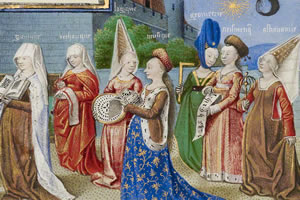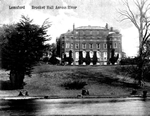George IV


Elizabeth Millbanke who was a mistress of the Prince Regent
Sir Matthew's son Peniston became the first Lord Melbourne, largely through the efforts of his wife Elizabeth Millbanke who was a mistress of the Prince Regent, later George IV, who was a frequent visitor to Brocket Hall.
George IV was 48 when he became Regent in 1811, as a result of the illness of his father, George III.
He had secretly and illegally married a Roman Catholic, Mrs Fitzherbert. In 1795 he officially married Princess Caroline of Brunswick, but the marriage was a failure and he tried unsuccessfully to divorce her after his accession in 1820 (Caroline died in 1821). Their only child Princess Charlotte died giving birth to a stillborn child.
An outstanding, if extravagant, collector and builder, George IV acquired many important works of art (now in the Royal Collection), built the Royal Pavilion at Brighton, and transformed Windsor Castle and Buckingham Palace. George's fondness for pageantry helped to develop the ceremonial side of monarchy.
After his father's long illness, George resumed royal visits; he visited Hanover in 1821 (it had not been visited by its ruler since the 1750s), and Ireland and Scotland over the next couple of years.
Beset by debts, George was in a weak position in relation to his Cabinet of ministers. His concern for royal prerogative was sporadic; when the Prime Minister Lord Liverpool fell ill in 1827, George at one stage suggested that ministers should choose Liverpool's successor.
In 1829, George IV was forced by his ministers, much against his will and his interpretation of his coronation oath, to agree to Catholic Emancipation. By reducing religious discrimination, this emancipation enabled the monarchy to play a more national role.
George's profligacy and marriage difficulties meant that he never regained much popularity, and he spent his final years in seclusion at Windsor, dying at the age of 67.
Extra Information from www.royal.gov.uk/historyofthemonarchy
Image from LLHG
Contact Us Today info@lemsfordhistory.co.uk. Images and articles welcomed
New Brocket Hall
The estate was sold to Sir Matthew Lamb in 1746 by Thomas Wiinnington . This era was an eventful time Sir Matthew engaged one of the leading architects of the day Sir James Paine and asked him to build a new Brocket hall and Paine did just that. Sir Matthew died around 1765.
James Paine (1717–1789) was an English architect.Essentially a Palladian, early in his career he was Clerk of Works at Nostell Priory, and worked on many other projects in the area including Heath House in the village of Heath in between Nostell Priory and Wakefield.From the 1750s, he had his own practice, and designed many villas, usually consisting of a central building, often with a fine staircase, and two symmetrical wings.
Wikipedia
Early Days
LAround this area had several manors,Symonshyde, Benstead, Heron, and Chewells around the time of Henry III (1207 to 1272 ) these mannors merge and become ‘Watershyppes’Early evidence suggests the house dates back to 1239 and was owned by Simon Fitz Ade. They were also known as FitzSymon.


The Families of Brocket Hall
Early evidence suggests the house dates back to 1239 and was owned by Simon Fitz Ade. They were also known as FitzSymon.
Thomas Lord Fauconberg born 1341 and married to Joan Nevile born 1363 – daughter Joan De Fauconberg Born 1367 :
The most famous of the Brocket family was Sir John Brocket, who married Helen, daughter of Sir Rowland Lytton of Knebworth in 1558 . Sir John Brocket and was high sheriff of Hertfordshire in 1553. Sir John was a close ally of Elizabeth 1st,. Elizabeth was under house arrest at nearby Hatfield house.
The estate was sold to Sir Matthew Lamb in 1746 by Thomas Wiinnington . This era was an eventful time Sir Matthew engaged one of the leading architects of the day Sir James Paine and asked him to build a new Brocket hall and Paine did just that. Sir Matthew died around 1765.
Stephens retired to England. He was created a Baronet, of Montreal in the Province of Quebec in the Dominion of Canada, in 1886, and raised to the peerage as Baron Mount Stephen, of Mount Stephen in the Province of British Columbia and Dominion of Canada
On the death of Lord Mount Stephen in 1921 the house was put up for sale and bought in 1923 by Sir Charles Nall –Cain of the Node Codicote. Sir Charles took the title ‘Lord Brocket ‘ in 1933 and on his death in the following year the estate passed onto his only son Arthur Ronald Nall- Cain (1904 – 1966) Lord Brocket.